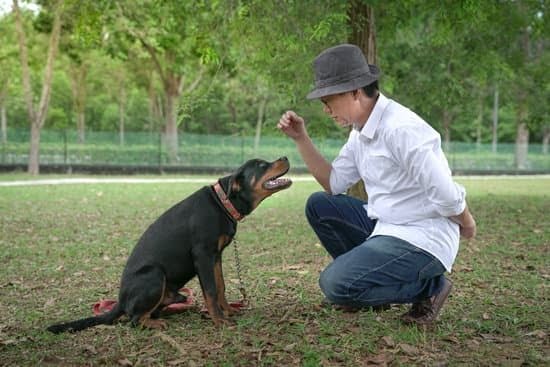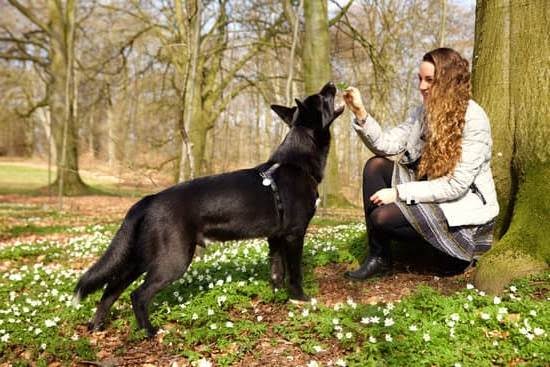Introduction
Training your dog to follow commands can bring many benefits to you and your pup. When done properly, it can improve communication between the two of you and help create a strong bond built on trust and respect. Additionally, proper socialization, which includes obedience training, can help prevent undesirable behaviors such as excessive barking or digging, jumping on furniture and people, running away, chasing people or other animals, and more. It can also provide mental stimulation and exercise for your pup while giving them structure in their life. Furthermore, proper training will aid with potty training and provide consistency so that your pup knows what is expected of him. Proper obedience training also prepares your pet for future behavior problems by teaching appropriate responses rather than punishing mistakes after the fact. Lastly, being able to control his behavior in public situations gives peace of mind knowing that you can prevent unfortunate interactions between humans and animals in crowded spaces or off-leash locations.
Benefits of Training Your Dog to Follow Commands
Training your dog to follow commands is not only beneficial for humans, but also beneficial for dogs. It can help you to have better control over your canine friend and also allow them to have greater structure in their routine. Dogs given commands are generally more well-behaved, as they understand that certain actions are expected of them. Commands can also help establish a strong bond between pet and owner, which is an essential part of the ownership experience.
Some of the specific benefits include teaching your dog obedience. Obedience training allows them to be mindful of directions and orders so they can respond quicker when needed in certain situations. This type of training is also great for behavior modification and helping your dog become more aware of their behaviors. Teaching commands can also provide mental stimulation as dogs enjoy problem solving activities that come with learning new things. Additionally, having this structured environment around them gives dogs a sense of security and comfort knowing what is expected from them when instructed. Finally, learning commands provides strenuous activity for a dog that could easily become bored or lazy when lacking stimulation.
Connecting with Your Dog
To have success in teaching your dog to follow commands, it is important to create a strong bond between you and your pet. Begin by making sure that all interactions with your pup are positive and reward-focused. This means offering praise, treats, and gentle caressing whenever they do something right. Additionally, ensure your dog feels safe around you by providing consistency in both instructions and expectations. Involve them in fun activities such as an outing in the park or a game of fetch played slightly differently each day to keep things fresh and enjoyable for them. Building an effective relationship between owner and pup will make the training process much smoother.
Getting Started
Training a dog to follow commands is an important part of responsible pet ownership. Before beginning any training program, it is essential to understand the principles behind reinforcement and repetition. Reinforcement is when a behavior is rewarded or reinforced for doing something correctly. Repetition is done by repeating the same behavior on a consistent basis in order to teach the desired command.
When picking out treats to use for reinforcement, remember to use rewards that your dog finds valuable — like pieces of cooked chicken or bits of cheese, which they don’t usually get through their day-to-day diet. Trainers should also be aware of canine body language, as certain signs may indicate whether a reward was effective or not. For example, a wagging tail might indicate that the dog enjoyed the reward given and will look forward further rewards in the future!
When it comes time for actual command training, start with basic orders such as sit or stay. Begin by introducing one command at a time—first saying the command before proceeding with the action and then rewarding them with a treat upon completing each task successfully. Then start implementing repetition into each session so as to solidify good behavior—repeat practical commands several times per day while continuing to offer positive reinforcement along the way. Through proper repetition and reinforcement over time, a well-behaved pup can be achieved!
Teaching the Core Commands
Training your dog to follow basic commands such as sit, stay, and come is essential for establishing a positive relationship with your pet. Studies have shown that using positive reinforcement is the most effective method for teaching a dog to respond to commands. Positive reinforcement simply involves rewarding desirable behavior with treats, toys, or other rewards to increase the likelihood that the behavior will be repeated in the future. Negative reinforcement should also be used judiciously in order to discourage any unwanted behaviors. This may involve a swift verbal reprimand, time-outs away from play time, or removal of a desirable outcome (for example, taking away a treat).
When training your dog it’s important to remain consistent and reliable. Break tasks into smaller commands so your dog can better understand what is being asked of them. Be sure to reward when they succeed and only correct their behavior where necessary. Additionally, you must use commands consistently and refrain from using multiple commands at once; give them an opportunity to learn each command one at a time. In terms of timing, aim to reinforce immediately after your dog has successfully completed an action: the sooner the better! You should also practice regularly in order to help aid in generalizing new skills and improving overall performance. Finally, keep sessions short: start by only doing 2-5 minutes of training every day and gradually increase it as your pup progresses.
Re-inforcing Effective Responses
Once your dog has learned the basics of following commands, it’s important to reinforce their obedience with positive reinforcement. The most effective way to do so is to use a reward system. When choosing which type of reward to give your pooch, there are generally three different options you can choose from: food rewards, toys and praise. Each one will depend on what works best for your pet; different dogs have differing preferences when it comes to being rewarded!
Food rewards are usually small pieces of treats such as kibble or special treat bites that can be easily given by hand. These treats should be used only when your dog has done something well and not as an everyday snack. For example, when your canine companion responds successfully to a command, you could give him or her a small treat as a reward for their good behavior.
Toys are also great incentives for teaching dogs commands – particularly when learning something new that’s more complicated than the basics! After using verbal instructions, you can use a toy as a visual cue to get them interested and excited about what they need to do before providing any treats or verbal praise afterwards. This is great for keeping them engaged in training sessions.
When it comes to praise, the key is consistency and frequency! Use verbal cues such as ‘good boy’ or ‘well done’ whenever you want your pup to know they did something right. You don’t have to use these words on every successful attempt but make sure they hear them enough so they become familiar with what you mean by them – i.e., success! Lastly, physical affection such as petting and cuddles can also be used alongside verbal and/or tangible rewards like food or toys
Practicing Commands and Building Complexity
Training a dog to follow commands is essential for any owner who wants a positive relationship and mutual respect between themselves and their pet. When it comes to how to train a dog, consistency and patience are key. After teaching your dog the basic commands such as “sit”, “stay”, and “come”, you should begin building upon those basics by continuing to practice them on a more complex level. Start by adding verbal cues such as “Quick Sit!” or introduce distractions such as another person who will walk near you during training sessions, or receive prompts from treats. Consistency will ensure that your pup picks up any new commands quickly. You can also develop create combinations with different items which involve multiple, chain commands. For instance, if you want your dog to go get his toy, you can say “Fetch! Go get your ball!” This will require him to remember two separate steps in order to successfully complete the task. Another helpful tip is to reward your pup each time he follows a new command correctly – this reward system reinforces the behavior that you wish to promote in your pup. With consistent effort and patience, you will soon have a well-trained pup who knows how to respond to all of your instructions.
Progressing Difficulty Levels with Patience and Care
Training a dog to respond to commands can be a lengthy process, but it’s also incredibly rewarding. Dogs can learn anything from simple tasks such as sitting, staying and coming to more complex commands like going to their bed or retrieving objects. The key is practicing regularly, with patience and care.
To make sure your dog learns the commands properly, you need to progress gradually in difficulty levels. Start out with simple commands such as “sit” or “stay” for short periods of time and then move on to more difficult tasks like “come,” “down,” or locating specific objects by name. After each command, reward your pup with praise or treats; this will help reinforce their understanding of the task as well as boost their motivation for mastering it. Additionally, make sure you don’t overwork them- allow plenty of breaks and playtime in between training sessions!
Furthermore, try not to repeat acommand too many times if your pup isn’t responding; always work at their pace and start by providing lots of positive reinforcement when they get things right. If they receive too much negative feedback in response to failing a command, they will become demotivated and lose enthusiasm for learning altogether. Ensure that all your commands are consistent- use the same words every time so that your pet isn’t confused -and keep up with regular practice until you see clear results. Following these steps should result in quick yet enjoyable mastery of basic commands!
Understanding Behavior
Training a dog to follow commands is an important process in ensuring that your pet is safe and well-behaved. When teaching your dog certain commands, it is important to approach the training with patience and understanding. If your dog shows signs of refusing to follow the commands you give them, it could be a sign that they are overwhelmed or confused. In these instances, it is best to take a step back and redirect them with more positive reinforcement. Choose an option that works best for you and tailor it to fit your pooch’s personality. For example, if your pup is food motivated offer treats as rewards for following commands. If they are more enticed by physical activity, incorporate playtime into the session once they accomplish their goal. As long as you stay consistent and remain positive in all interactions with your pup they will eventually become more comfortable with the commands you are asking of them!
Bringing it all Together
Training your dog to follow commands can provide an immense range of benefits. The most obvious benefit is the improved safety and behavior of your pet, as having a well-behaved dog that follows directions can help minimize risks like running away, aggressive behavior or other dangerous actions. Additionally, the bond between owner and pet can increase through the satisfaction gained from successful communication. Training strengthens that bond as it creates a two-way relationship between the two: your dog will be better able to understand what you need from it, leading to a stronger mutual understanding. Many owners also find that teaching their dogs simple commands helps alleviate anxiety, teaching them how to interact with both humans and other animals in different environments. On top of this, training sessions provide some type of mental stimulation for the dog — boosting their intelligence and helping keep them engaged — which in turn makes them easier to take care of overall. Finally, once you have successfully trained your dog to follow commands, you will find social situations like going for walks or visiting friends are often much easier due to their newfound obedience skills.

Welcome to the blog! I am a professional dog trainer and have been working with dogs for many years. In this blog, I will be discussing various topics related to dog training, including tips, tricks, and advice. I hope you find this information helpful and informative. Thanks for reading!





